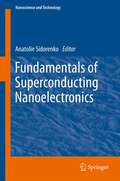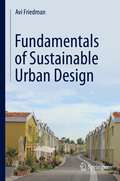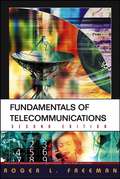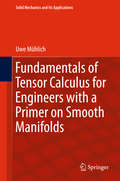- Table View
- List View
Fundamentals of Structural Optimization: Shape, Anisotropy, Topology (Mathematical Engineering)
by Vladimir KobelevThis book provides a comprehensive overview of analytical methods for solving optimization problems, covering principles and mathematical techniques alongside numerical solution routines, including MAPLE and MAXIMA optimization routines. Each method is explained with practical applications and ANSYS APDL scripts for select problems. Chapters delve into topics such as scaling methods, torsion compliance, shape variation, topological optimization, anisotropic material properties, and differential geometry. Specific optimization problems, including stress minimization and mass reduction under constraints, are addressed. The book also explores isoperimetric inequalities and optimal material selection principles. Appendices offer insights into tensors, differential geometry, integral equations, and computer algebra codes. Overall, it's a comprehensive guide for engineers and researchers in structural optimization.
Fundamentals of Superconducting Nanoelectronics (NanoScience and Technology)
by Anatoli SidorenkoThis book demonstrates how the new phenomena in superconductivity on the nanometer scale (FFLO state, triplet superconductivity, Crossed Andreev Reflection, synchronized generation etc.) serve as the basis for the invention and development of novel nanoelectronic devices and systems. It demonstrates how rather complex ideas and theoretical models, like odd-pairing, non-uniform superconducting state, pi-shift etc., adequately describe the processes in real superconducting nanostructues and novel devices based on them. The book is useful for a broad audience of readers, researchers, engineers, PhD-students, lectures and others who would like to gain knowledge in the frontiers of superconductivity at the nanoscale.
Fundamentals of Sustainability in Civil Engineering
by Andrew BrahamThis book will provide a foundation to understand the development of sustainability in civil engineering, and tools to address the three pillars of sustainability: economics, environment, and society. It will also include case studies in the four major areas of civil engineering: environmental, structural, geotechnical, and transportation, and utilize the concepts found on the Fundamentals of Engineering (FE) exam. It is intended for upper-level civil engineering sustainability courses. In addition, practical report writing and presentation giving will be proposed as evaluation metrics versus standard numerical questions and exam-based evaluations found in most civil engineering courses.
Fundamentals of Sustainability in Civil Engineering
by Andrew BrahamThis book will provide a foundation to understand the development of sustainability in civil engineering, and tools to address the three pillars of sustainability: economics, environment, and society. It will also include case studies in the four major areas of civil engineering: environmental, structural, geotechnical, and transportation, and utilize the concepts found on the Fundamentals of Engineering (FE) exam. It is intended for upper-level civil engineering sustainability courses. In addition, practical report writing and presentation giving will be proposed as evaluation metrics versus standard numerical questions and exam-based evaluations found in most civil engineering courses.
Fundamentals of Sustainability in Civil Engineering
by Andrew Braham Sadie CasillasThis book provides a foundation to understand the development of sustainability in civil engineering, and tools to address the three pillars of sustainability: economics, environment, and society. It includes case studies in the five major areas of civil engineering: environmental, structural, geotechnical, transportation, and construction management. This second edition is updated throughout and adds new chapters on construction engineering as well as an overview of the most common certification programs that revolve around environmental sustainability. Features: Updated throughout and adds two entirely new chapters Presents a review of the most common certification programs in sustainability Offers a blend of numerical and writing-based problems, as well as numerous application-based examples that utilize concepts found on the Fundamentals of Engineering (FE) exam Includes several practical case studies Offers a solution manual for instructors Fundamentals of Sustainability in Civil Engineering is intended for upper-level civil engineering sustainability courses. A unique feature is that concepts found in the Fundamentals of Engineering (FE) exam were targeted to help senior-level students refresh and prepare.
Fundamentals of Sustainability in Civil Engineering
by Andrew Braham Sadie CasillasThis book provides a foundation to understand the development of sustainability in civil engineering, and tools to address the three pillars of sustainability: economics, environment, and society. It includes case studies in the five major areas of civil engineering: environmental, structural, geotechnical, transportation, and construction management. This second edition is updated throughout and adds new chapters on construction engineering as well as an overview of the most common certification programs that revolve around environmental sustainability. Features: Updated throughout and adds two entirely new chapters Presents a review of the most common certification programs in sustainability Offers a blend of numerical and writing-based problems, as well as numerous application-based examples that utilize concepts found on the Fundamentals of Engineering (FE) exam Includes several practical case studies Offers a solution manual for instructors Fundamentals of Sustainability in Civil Engineering is intended for upper-level civil engineering sustainability courses. A unique feature is that concepts found in the Fundamentals of Engineering (FE) exam were targeted to help senior-level students refresh and prepare.
Fundamentals of Sustainable Aviation (ISSN)
by Eva MalevitiFundamentals of Sustainable Aviation is the first textbook to survey the critical field of sustainability within the aviation industry. Taking a systems thinking approach, it presents the foundational principles of sustainability and methodically applies them to different aviation sectors.Opening with the basics of sustainability, emphasising the Sustainable Development Goals, the book then considers the environmental, economic and social dimensions of aviation. The following chapters apply these insights to aviation design, supply chains, operations, maintenance and facilities. The final chapter examines the concept of resilience in sustainable aviation. Overall, the textbook shows how future sustainability can be achieved by making better decisions today.Students are supported with international case studies throughout the book. Slides, test questions and a teaching manual are available for instructors. This textbook is the ideal resource for courses on sustainable aviation globally and will also be of great interest to professionals in the field.
Fundamentals of Sustainable Aviation (ISSN)
by Eva MalevitiFundamentals of Sustainable Aviation is the first textbook to survey the critical field of sustainability within the aviation industry. Taking a systems thinking approach, it presents the foundational principles of sustainability and methodically applies them to different aviation sectors.Opening with the basics of sustainability, emphasising the Sustainable Development Goals, the book then considers the environmental, economic and social dimensions of aviation. The following chapters apply these insights to aviation design, supply chains, operations, maintenance and facilities. The final chapter examines the concept of resilience in sustainable aviation. Overall, the textbook shows how future sustainability can be achieved by making better decisions today.Students are supported with international case studies throughout the book. Slides, test questions and a teaching manual are available for instructors. This textbook is the ideal resource for courses on sustainable aviation globally and will also be of great interest to professionals in the field.
Fundamentals of Sustainable Drilling Engineering (Wiley-Scrivener)
by M. E. Hossain Abdulaziz Abdullah Al-MajedThe book clearly explains the concepts of the drilling engineering and presents the existing knowledge ranging from the history of drilling technology to well completion. This textbook takes on the difficult issue of sustainability in drilling engineering and tries to present the engineering terminologies in a clear manner so that the new hire, as well as the veteran driller, will be able to understand the drilling concepts with minimum effort. This textbook is an excellent resource for petroleum engineering students, drilling engineers, supervisors & managers, researchers and environmental engineers for planning every aspect of rig operations in the most sustainable, environmentally responsible manner, using the most up-to-date technological advancements in equipment and processes.
Fundamentals of Sustainable Drilling Engineering (Wiley-Scrivener)
by M. E. Hossain Abdulaziz Abdullah Al-MajedThe book clearly explains the concepts of the drilling engineering and presents the existing knowledge ranging from the history of drilling technology to well completion. This textbook takes on the difficult issue of sustainability in drilling engineering and tries to present the engineering terminologies in a clear manner so that the new hire, as well as the veteran driller, will be able to understand the drilling concepts with minimum effort. This textbook is an excellent resource for petroleum engineering students, drilling engineers, supervisors & managers, researchers and environmental engineers for planning every aspect of rig operations in the most sustainable, environmentally responsible manner, using the most up-to-date technological advancements in equipment and processes.
Fundamentals of Sustainable Neighbourhoods
by Avi FriedmanThis timely book introduces architects, engineers, builders, and urban planners to a range of contemporary community design concepts and illustrates them with outstanding case studies from around the world. Drawing on successful projects from London, New Mexico, Austria, and the Netherlands, "Innovative Sustainable Communities" presents planning concepts that minimize developments' carbon footprint through compact communities, adaptable and expandable dwellings, edible landscape, and smaller-sized yet quality designed housing.
Fundamentals of Sustainable Urban Design
by Avi FriedmanThis book begins with an introduction describing current societal transformations that merit new urban designs, including depletion of non-renewable natural resources, elevated levels of greenhouse gas emissions, large numbers of aging “Baby Boomers,” and climate change. Dr. Friedman then examines these challenges through thirty chapters of interest to urban designers, architects, civil and construction engineers, and town planners. Each of these topics represents an aspect of urban design and describes an innovative solution and offers a detailed description of underlying principles. The highly illustrated text presents innovative urban design strategies based on sustainable principles. Integrated with each chapter are several international case studies illustrating design implementations.
Fundamentals of Sustainable Urban Renewal in Small and Mid-Sized Towns
by Avi FriedmanThe book introduces challenges affecting smaller urban communities with fewer than 50,000 inhabitants and offers urban planning and building/architectural strategies to strengthen their city centers. It divides urban renewal of small towns into sub-components such as environmental challenges, demographic trends, economic changes and cultural aspects, and aging infrastructure. In each, context is established, and principles are outlined and illustrated. Topics include urban form, mobility and connectivity, infill neighborhoods design, wealth generation, and promotion of local culture and well‐being. Reinforced with detailed case studies, Fundamentals of Sustainable Urban Renewal in Small and Mid‐Sized Towns is an ideal resource for municipal planners, architects, civil engineers, and policy makers.
Fundamentals of Switching Theory and Logic Design: A Hands on Approach
by Jaakko Astola Radomir S. StankovicFundamentals of Switching Theory and Logic Design discusses the basics of switching theory and logic design from a slightly alternative point of view and also presents links between switching theory and related areas of signal processing and system theory. Switching theory is a branch of applied mathematic providing mathematical foundations for logic design, which can be considered as a part of digital system design concerning realizations of systems whose inputs and outputs are described by logic functions.
Fundamentals of Systems Biology: From Synthetic Circuits to Whole-cell Models
by Markus W. CovertFor decades biology has focused on decoding cellular processes one gene at a time, but many of the most pressing biological questions, as well as diseases such as cancer and heart disease, are related to complex systems involving the interaction of hundreds, or even thousands, of gene products and other factors. How do we begin to understand this complexity? Fundamentals of Systems Biology: From Synthetic Circuits to Whole-cell Models introduces students to methods they can use to tackle complex systems head-on, carefully walking them through studies that comprise the foundation and frontier of systems biology. The first section of the book focuses on bringing students quickly up to speed with a variety of modeling methods in the context of a synthetic biological circuit. This innovative approach builds intuition about the strengths and weaknesses of each method and becomes critical in the book’s second half, where much more complicated network models are addressed—including transcriptional, signaling, metabolic, and even integrated multi-network models. The approach makes the work much more accessible to novices (undergraduates, medical students, and biologists new to mathematical modeling) while still having much to offer experienced modelers--whether their interests are microbes, organs, whole organisms, diseases, synthetic biology, or just about any field that investigates living systems.
Fundamentals of Systems Biology: From Synthetic Circuits to Whole-cell Models
by Markus W. CovertFor decades biology has focused on decoding cellular processes one gene at a time, but many of the most pressing biological questions, as well as diseases such as cancer and heart disease, are related to complex systems involving the interaction of hundreds, or even thousands, of gene products and other factors. How do we begin to understand this complexity? Fundamentals of Systems Biology: From Synthetic Circuits to Whole-cell Models introduces students to methods they can use to tackle complex systems head-on, carefully walking them through studies that comprise the foundation and frontier of systems biology. The first section of the book focuses on bringing students quickly up to speed with a variety of modeling methods in the context of a synthetic biological circuit. This innovative approach builds intuition about the strengths and weaknesses of each method and becomes critical in the book’s second half, where much more complicated network models are addressed—including transcriptional, signaling, metabolic, and even integrated multi-network models. The approach makes the work much more accessible to novices (undergraduates, medical students, and biologists new to mathematical modeling) while still having much to offer experienced modelers--whether their interests are microbes, organs, whole organisms, diseases, synthetic biology, or just about any field that investigates living systems.
Fundamentals of Systems Biology: From Synthetic Circuits to Whole-cell Models
by Markus W. CovertFor decades biology has focused on decoding cellular processes one gene at a time, but many of the most pressing biological questions, as well as diseases such as cancer and heart disease, are related to complex systems involving the interaction of hundreds, or even thousands, of gene products and other factors. How do we begin to understand this complexity? Fundamentals of Systems Biology: From Synthetic Circuits to Whole-cell Models introduces students to methods they can use to tackle complex systems head-on, carefully walking them through studies that comprise the foundation and frontier of systems biology. The first section of the book focuses on bringing students quickly up to speed with a variety of modeling methods in the context of a synthetic biological circuit. This innovative approach builds intuition about the strengths and weaknesses of each method and becomes critical in the book’s second half, where much more complicated network models are addressed—including transcriptional, signaling, metabolic, and even integrated multi-network models. The approach makes the work much more accessible to novices (undergraduates, medical students, and biologists new to mathematical modeling) while still having much to offer experienced modelers--whether their interests are microbes, organs, whole organisms, diseases, synthetic biology, or just about any field that investigates living systems.
Fundamentals of Technical Thermodynamics: Textbook for Engineering Students
by Martin Dehli Ernst Doering Herbert SchedwillThis textbook presents the essential scientific principles of thermodynamics in a detailed and well-structured manner for practice-oriented teaching. It conveys analytically reliable knowledge with a view to engineering application and provides the key to a quick understanding of e.g. thermal machines, heat transfer, humid air and combustion. The present English edition - in comparison to earlier German editions - has been extended to include aspects of fluid mechanics, dynamics of ideal gases and chemical thermodynamics.
Fundamentals of Telecommunications (Wiley Series in Telecommunications and Signal Processing #92)
by Roger L. FreemanThe Second Edition of this critically-acclaimed text continues the standard of excellence set in the first edition by providing a thorough introduction to the fundamentals of telecommunication networks without bogging you down in complex technical jargon or math. Although focusing on the basics, the book has been thoroughly updated with the latest advances in the field, including a new chapter on metropolitan area networks (MANs) and new sections on Mobile Fi, ZigBee and ultrawideband. You’ll learn which choices are now available to an organization, how to evaluate them and how to develop strategies that achieve the best balance among cost, security and performance factors for voice, data, and image communication.
Fundamentals of Tensor Calculus for Engineers with a Primer on Smooth Manifolds (Solid Mechanics and Its Applications #230)
by Uwe MühlichThis book presents the fundamentals of modern tensor calculus for students in engineering and applied physics, emphasizing those aspects that are crucial for applying tensor calculus safely in Euclidian space and for grasping the very essence of the smooth manifold concept.After introducing the subject, it provides a brief exposition on point set topology to familiarize readers with the subject, especially with those topics required in later chapters.It then describes the finite dimensional real vector space and its dual, focusing on the usefulness of the latter for encoding duality concepts in physics. Moreover, it introduces tensors as objects that encode linear mappings and discusses affine and Euclidean spaces. Tensor analysis is explored first in Euclidean space, starting from a generalization of the concept of differentiability and proceeding towards concepts such as directional derivative, covariant derivative and integration based on differential forms. The final chapter addresses the role of smooth manifolds in modeling spaces other than Euclidean space, particularly the concepts of smooth atlas and tangent space, which are crucial to understanding the topic. Two of the most important concepts, namely the tangent bundle and the Lie derivative, are subsequently worked out.
Fundamentals of Terahertz Devices and Applications
by Dimitris PavlidisAn authoritative and comprehensive guide to the devices and applications of Terahertz technology Terahertz (THz) technology relates to applications that span in frequency from a few hundred GHz to more than 1000 GHz. Fundamentals of Terahertz Devices and Applications offers a comprehensive review of the devices and applications of Terahertz technology. With contributions from a range of experts on the topic, this book contains in a single volume an inclusive review of THz devices for signal generation, detection and treatment. Fundamentals of Terahertz Devices and Applications offers an exploration and addresses key categories and aspects of Terahertz Technology such as: sources, detectors, transmission, electronic considerations and applications, optical (photonic) considerations and applications. Worked examples—based on the contributors' extensive experience— highlight the chapter material presented. The text is designed for use by novices and professionals who want a better understanding of device operation and use, and is suitable for instructional purposes This important book: Offers the most relevant up-to-date research information and insight into the future developments in the technology Addresses a wide-range of categories and aspects of Terahertz technology Includes material to support courses on Terahertz Technology and more Contains illustrative worked examples Written for researchers, students, and professional engineers, Fundamentals of Terahertz Devices and Applications offers an in-depth exploration of the topic that is designed for both novices and professionals and can be adopted for instructional purposes.
Fundamentals of Terahertz Devices and Applications
by Dimitris PavlidisAn authoritative and comprehensive guide to the devices and applications of Terahertz technology Terahertz (THz) technology relates to applications that span in frequency from a few hundred GHz to more than 1000 GHz. Fundamentals of Terahertz Devices and Applications offers a comprehensive review of the devices and applications of Terahertz technology. With contributions from a range of experts on the topic, this book contains in a single volume an inclusive review of THz devices for signal generation, detection and treatment. Fundamentals of Terahertz Devices and Applications offers an exploration and addresses key categories and aspects of Terahertz Technology such as: sources, detectors, transmission, electronic considerations and applications, optical (photonic) considerations and applications. Worked examples—based on the contributors' extensive experience— highlight the chapter material presented. The text is designed for use by novices and professionals who want a better understanding of device operation and use, and is suitable for instructional purposes This important book: Offers the most relevant up-to-date research information and insight into the future developments in the technology Addresses a wide-range of categories and aspects of Terahertz technology Includes material to support courses on Terahertz Technology and more Contains illustrative worked examples Written for researchers, students, and professional engineers, Fundamentals of Terahertz Devices and Applications offers an in-depth exploration of the topic that is designed for both novices and professionals and can be adopted for instructional purposes.
Fundamentals of the Fuzzy Logic-Based Generalized Theory of Decisions (Studies in Fuzziness and Soft Computing)
by Rafik Aziz AlievEvery day decision making and decision making in complex human-centric systems are characterized by imperfect decision-relevant information. Main drawback of the existing decision theories is namely incapability to deal with imperfect information and modeling vague preferences. Actually, a paradigm of non-numerical probabilities in decision making has a long history and arose also in Keynes’s analysis of uncertainty. There is a need for further generalization – a move to decision theories with perception-based imperfect information described in NL. The languages of new decision models for human-centric systems should be not languages based on binary logic but human-centric computational schemes able to operate on NL-described information. Development of new theories is now possible due to an increased computational power of information processing systems which allows for computations with imperfect information, particularly, imprecise and partially true information, which are much more complex than computations over numbers and probabilities.The monograph exposes the foundations of a new decision theory with imperfect decision-relevant information on environment and a decision maker’s behavior. This theory is based on the synthesis of the fuzzy sets theory with perception-based information and the probability theory.The book is self containing and represents in a systematic way the decision theory with imperfect information into the educational systems. The book will be helpful for teachers and students of universities and colleges, for managers and specialists from various fields of business and economics, production and social sphere.
Fundamentals of the Optics of Materials: Tutorial and Problem Solving
by Vladimir I. Gavrilenko Volodymyr S. OvechkoThis textbook showcases the rapidly developing field of materials optics. It is aimed at a broad audience as the readers require only university entry level knowledge of physics, chemistry, and optics. It overviews the basics of optical engineering and the typical and widely used applications of materials optics, with the first general chapters corresponding to the standard university courses, targeting bachelor’s and master’s degrees in physics. The next few chapters present the modern developments in materials optics, such as nano-plasmonics, nano-photonics, and optical properties of nano-sized materials, intended for readers familiar with the basic elements of quantum mechanics. Some more specialized chapters address recent developments in fields such as optics of solid surfaces, plasma optics, optics of composites, alloys, and metamaterials; optics of anisotropic materials; optics of organic and biological materials; and relativistic effects in optics. The appendices present a more advanced description of selected topics, with important reference materials, subject index, and extended list of publications, as well as numerous examples and problems to better orient readers interested in gaining further knowledge of the subject.

















